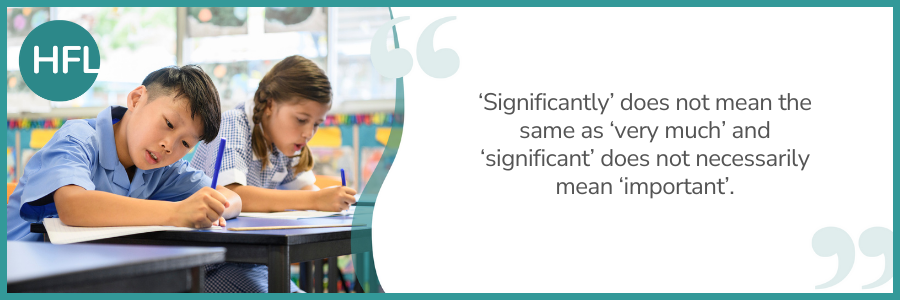
The technical details of the 2023 progress model for KS2 have now been published by the DfE. The model is broadly similar to the 2022 model, which I blogged about here. Every year there are minor adjustments to the ‘expected outcome’ for each Prior Attainment Group – these adjustments are down to slight changes in the national average outcomes each year.
The more significant change affecting the model this year relates to changes in the way children were assessed at KS1 in 2019, compared to 2018. (The 2019 KS1 cohort are of course the children who have just completed KS2.) The differences at KS1 relate to how children were assessed if they were working below the ‘Working Towards’ standard. 2019 saw the introduction of the 'Pre Key Stage Standards’ (PK1 to PK4 at KS1) and the removal of P-scales from P5 to P8. In constructing a model for calculating progress from KS1 to KS2 in 2023, scores needed to be assigned to each of these pre-key stage standards so that a measure of ‘prior attainment’ could be produced.
The range of scores used then for converting KS1 attainment into a prior attainment score for calculating KS2 progress now looks like this:
| GDS | 10 points |
| EXS | 8 points |
| WTS | 6 points |
| PK4 | 4 points |
| PK3 | 3.5 points |
| PK2 | 3 points |
| PK1 | 2.5 points |
For children with SEND assessed using P-scales, the points range from 0.25 (P1i) to 1.75 (P4).
As per previous years’ models, the prior attainment score is found by converting a child’s teacher assessments in reading, writing and maths into scores, from the above table, and then combining those three scores into one score as follows:
- calculate the average of their reading and writing scores, to give a score for English
- calculate the average of this English score and their maths score
Based on this ‘weighted average’ score, children are then allocated into a Prior Attainment Group (PAG) and this forms the input measure of the KS2 progress model (in all subjects).
The full details are available in the DfE’s technical guidance, but here are two simple examples:
Example 1 – a child who was assessed at EXS in all three subject areas at KS1
Their combined prior attainment score is 8 points.
In 2023, the national average scaled scores for children with a prior attainment score of 8 points were as follows:
| Reading | Writing | Maths |
| 105.38 | 102.02 | 104.61 |
This means that, to achieve a better than average progress score, children with this prior attainment need to score above those figures. If they achieved a scaled score of, say, 107 in reading, their progress score would be +1.62 (the difference between 107 and 105.38). If they achieved a scaled score of 103, their progress score would be -2.38.
These average outcome figures are only marginally different from those in the 2022 model (effectively the same, to the nearest whole number).
Example 2 – a child who was assessed at GDS in all three subject areas at KS1
Their combined prior attainment score is 10 points.
In 2023, the national average scaled scores for children with a prior attainment score of 8 points were as follows:
| Reading | Writing | Maths |
| 113.29 | 108.87 | 112.14 |
In this example, to achieve a positive progress score, the child would need to achieve a scaled score of at least 114 in reading or 113 in maths. These are both 1 scaled score higher than was the case in the 2022 progress model.
Understanding the way this works for writing is a bit more complicated, as I discussed in the blog about the 2022 progress model.
I have produced a free downloadable attainment & progress calculator tool (scroll to the bottom of this page to download it). Using this tool you can easily see for any pupil, by entering their KS1 attainment and either their raw scores from the KS2 tests or their scaled scores, what the ‘expectation’ (i.e. national average outcome) is in the 2023 model. The tool then calculates each pupil’s progress score and produces a cohort-level average progress score. It will also indicate whether this score would be deemed to be ‘statistically significant’ (more on this below).
A cautionary word about analysing this data
It is always best to start from the view that data can raise interesting questions and form the starting point of a discussion, rather than jump directly to conclusions from the data. Data tends to raise more questions than it answers.
The methodology used to calculate a progress model inevitably carries a bit of ‘statistical noise’ or margins of error, as it is based on what has happened ‘on average’ for different groups of pupils, but no child actually behaves in an ‘average’ way. Every child is unique and complex, and there are bound to be day-to-day differences in how they perform in an assessment activity. So, there may be children whose progress scores come as a surprise – maybe they performed better than you might have expected on the day of the test, or maybe the opposite. At cohort-level though, these variations (some positive, some negative) would hopefully mainly cancel each other out. It is when you find that a large proportion of learners within a cohort appear to have underperformed that we might begin to notice this as a pattern and ask questions about what happened.
This is where statistical significance can help us. As the size of the cohort increases, variations from the norm become more meaningful and might become more worthy of exploration.
It is important to be clear about what is meant by ‘significant’ in this context.
‘Significantly’ does not mean the same as ‘very much’ and ‘significant’ does not necessarily mean ‘important’
In common parlance we might use ‘significantly’ to mean ‘very much’ or ‘noticeably’, e.g. “it is significantly hotter today than yesterday”. In the language of statistics, ‘significantly’ has a more precise meaning than that – it is better to think of it as expressing a degree of confidence in the data. If a progress score is statistically significantly above or below the national average, what that means is that we can say with a high degree of confidence that progress in that school is above or below the average. It doesn’t necessarily mean that the progress score is a lot better or a lot worse than average, just that it is better or worse and that we can be pretty confident in that assertion. (95% confident, to be precise – although even a 95% certainty does still mean we will be wrong 5% of the time.)
Likewise, significance is not the same as importance. If something in the data is deemed to be statistically significant, that might mean it is important but, as the song goes, ‘it ain’t necessarily so’. (And something could be important even without being statistically significant.)
It is for the users of the data to interpret and decide (taking into account all their other contextual knowledge about a school and that particular cohort of children) whether something is important or meaningful. For example, we might observe a significant drop in results from 2022 to 2023 – but that drop might have been entirely expected based on the two cohorts being very different, so we wouldn’t necessarily be concluding that some radical action was required based on that one observation.
So, what about next year and beyond?
This 2023 data will be the last time we see KS2 progress scores for a few years. Next year, the children completing Year 6 will be the children who finished Year 2 in Summer 2020, when statutory assessments were cancelled due to Covid. The same applies to those children who complete KS2 in 2025. So, in those years there will only by KS2 attainment data – no progress measures at all (as has been confirmed by the DfE).
2026 and 2027 will see a return to progress scores based on the sort of methodology that we currently have in place, i.e. based on children’s progress from KS1. But after that it all changes. The children currently in Year 2 will not be statutorily assessed at the end of KS1 and their KS1 attainment will not be collected by the DfE. This cohort of children all took part in the Reception Baseline in the academic year 2021/22, and that will be the input measure used to calculate their progress when they complete KS2 in 2028. (This is, of course, assuming there are no changes to national policy between now and then.)
It is perhaps worth taking this opportunity to remind readers that progress is always more than just a number. The published progress scores serve to give us an indication of how well pupils have made progress compared to the national picture, but these statistics are always a proxy for what really matters, which is the actual lived experience of children in that school: how well have they made progress through a well-thought-out curriculum, how securely have they acquired the knowledge and skills expected of them, to equip them for the next phase of education? Even in the years when we will have no published progress scores, these will still be crucial questions to explore. I wrote more on this in a previous blog, What do we mean by ‘progress’ and how can we reassure ourselves that pupils are making it?



